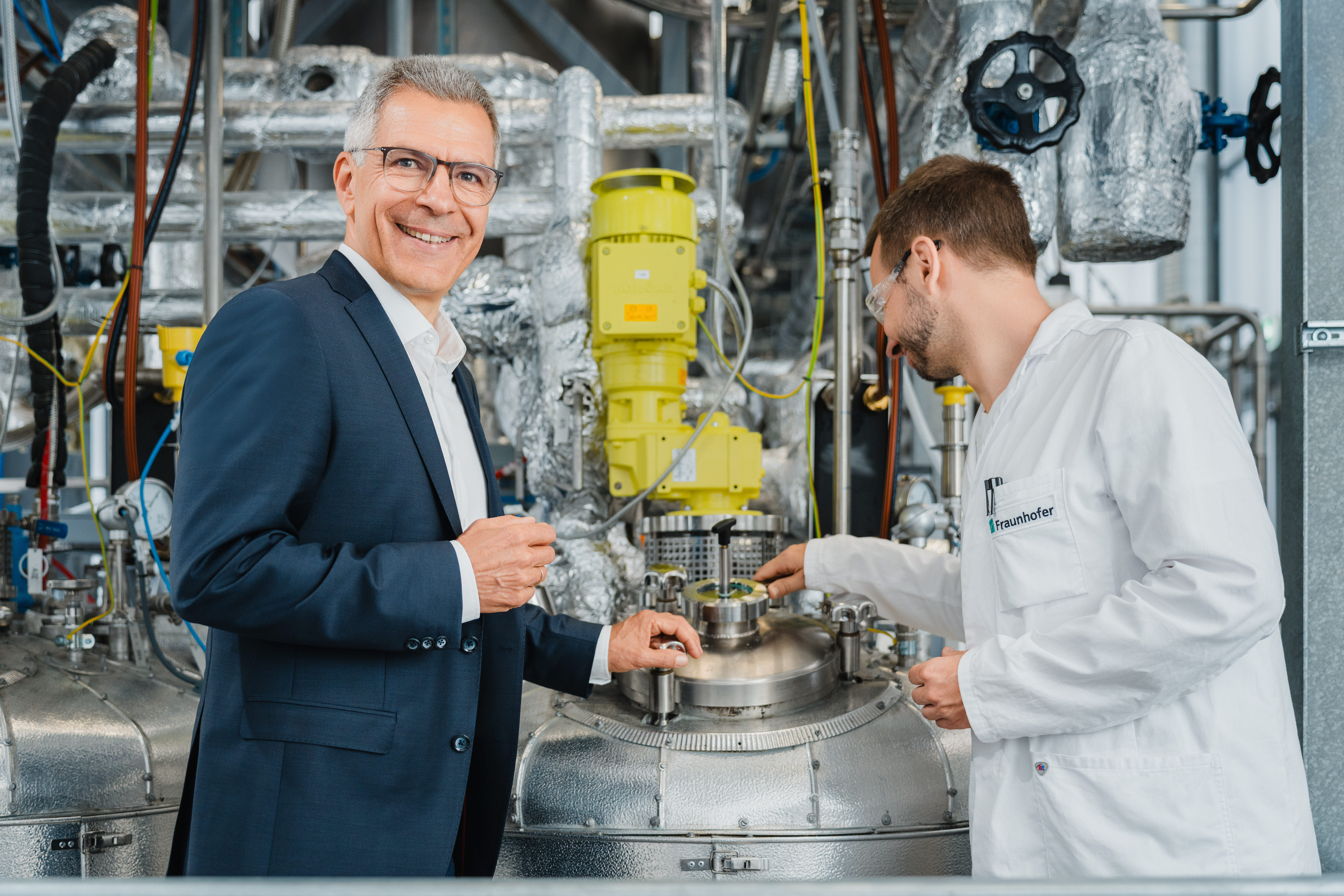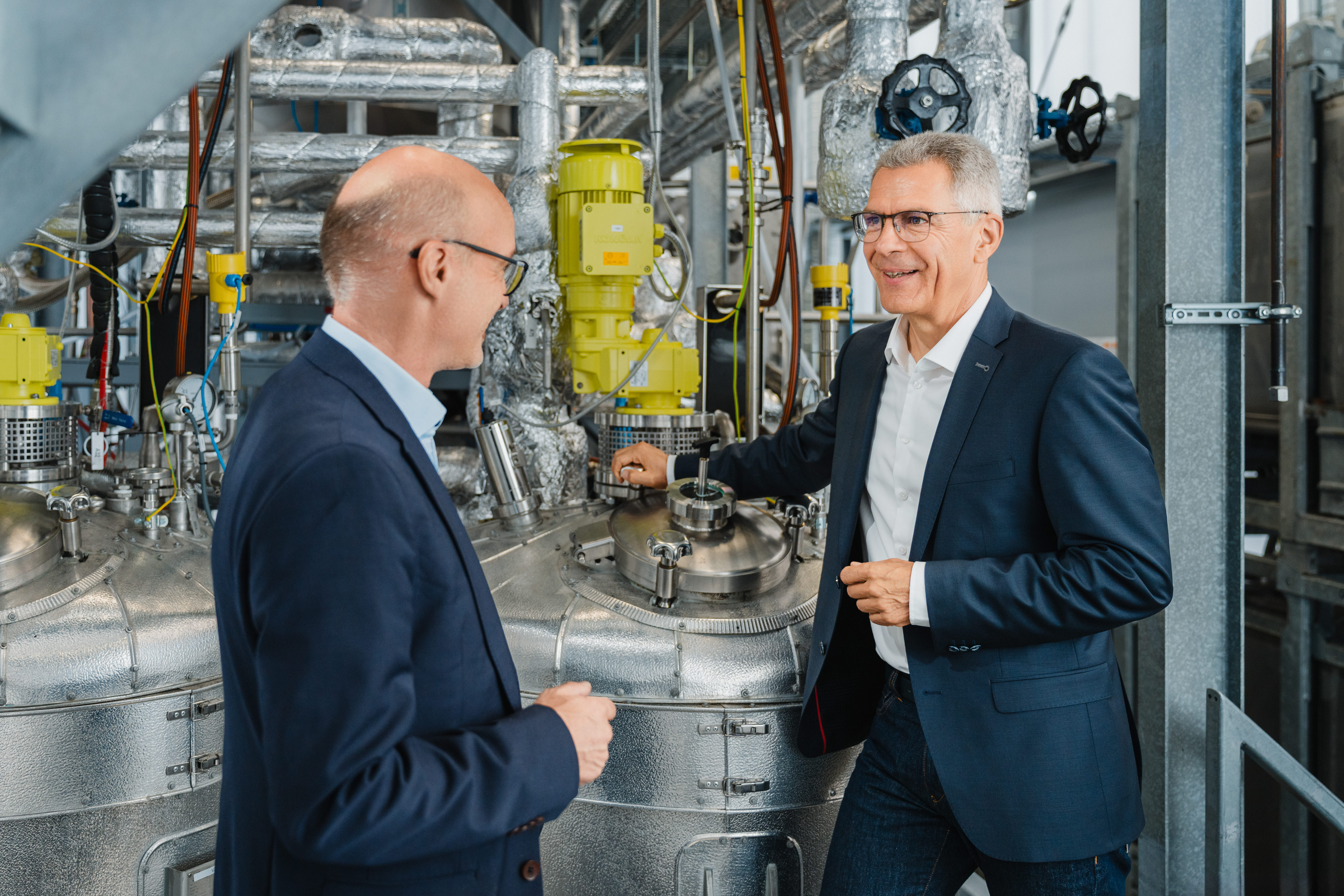Keeping plastics in the cycle with the Fraunhofer IVV's solvent-based recycling process
The Fraunhofer Institute for Process Engineering and Packaging IVV will be demonstrating how plastics can be successfully recovered from complex plastic mixtures at the K trade fair for plastics and rubber from October 8-15 in Düsseldorf. With the solvent-based recycling process developed at the Fraunhofer IVV, a wide variety of plastics from packaging, but also from the automotive, electronics, construction and textile sectors, can be recycled and processed into high-purity plastic recyclates. In this way, waste fractions that cannot be recycled using conventional recycling processes according to the state of the art become available for a circular economy with the solvent-based process. The Fraunhofer IVV will be exhibiting at the stand of the Fraunhofer Cluster Circular Plastics Economy CCPE in hall 7.0, stand 70SC05 under the motto "Bridge the Gap to Circularity".


The solvent-based recycling process is highly versatile. Dr. Andreas Mäurer will be available during the K trade fair to answer questions about the implementation of the process and the recovery of high-quality plastic recyclates. He is head of process development for polymer recycling at the Fraunhofer IVV and is a contact person in the Advanced Recycling Research Department of the Fraunhofer CCPE. "We even recover plastics that are difficult to recycle using solvent-based recycling," explains Dr. Mäurer. Compared to mechanical separation processes, it offers the advantage that the target polymer can be selectively dissolved and recovered in high purity. Foreign polymers and other solids remain undissolved and are effectively separated. Dissolved impurities such as flame retardants, plasticizers, degradation products and odors are separated by specific solvents, resulting in high purity recycled plastic. Solvent-based recycling is a physical process and an effective alternative to chemical recycling. This is because the polymers are not degraded and polymerization from chemically recycled raw materials is not necessary. A large-scale pilot plant is available at the Fraunhofer IVV to scale up solvent-based recycling to an industrial scale and to produce quantities of recyclate for industrial application tests. The Fraunhofer IVV is looking for partners to transfer the process to industrial plants.
High-purity recyclates for recyclable packaging - attractive colors and free of harmful substances
With the solvent-based recycling process, companies from various industries can achieve the ambitious goals of the new EU Packaging and Packaging Waste Regulation (PPWR). The process can be used for a wide range of applications and is suitable for both flexible and rigid packaging. Taking food safety into account, it meets the special requirements for cleaning efficiency. With the solvent-based recycling process, a cleaning efficiency of up to 99.8% has been achieved for both highly volatile and medium-volatile contaminants. The process enables the recycling of plastic from flexible packaging waste and the use of recycled materials in the production of new packaging for sensitive filling goods. The Fraunhofer IVV has already successfully implemented the integration of the recyclates obtained into flexible monomaterial packaging for food on a technical scale and realized a recyclate content of up to 30% in the developed packaging structure. In the sensitive personal & health care packaging sector, these recyclates have been used up to a proportion of 62%. In the general non-food sector, up to 100% recyclate content has also been used successfully.
Automotive sector: post-consumer recyclate from end-of-life vehicles for reuse in new vehicles
Sorting plastics from end-of-life vehicles, which contain a high proportion of composite materials and black components, has been a challenge to date. "We have reached a real milestone in plastics recycling and have successfully piloted the sorting of plastics from end-of-life vehicles," says Dr. Mäurer happily. The valuable thermoplastics, such as PC/ABS, are enriched from shredder residue fractions using mechanical processes and laser spectroscopic sorting to approx. 80-90% and further purified using the solvent-based recycling process. The result is a high purity recyclate that is then compounded with virgin material and additives, for example, to produce a PC/ABS with a high proportion of post-consumer recyclate (PCR). It even meets the high requirements for reuse in vehicle interiors. "We are thus enabling car manufacturers to meet the requirements of the European End-of-Life Vehicles Directive more easily. By 2030, 25% of the weight of plastics in new vehicles should be made from PCR plastics, a quarter of which should come from end-of-life vehicles," explains Dr. Mäurer.
Plastics from composite materials and thermoplastics - high-quality and pollutant-free recovery
"With our solvent-based recycling process, we also recover valuable plastic resources from composite materials or materials contaminated with harmful substances so that they can be returned to the cycle," explains Dr. Mäurer. "Plastics from old electrical appliances that cannot be recycled today, as the plastic content in electronic waste contains many different types of plastic and additional hazardous substances such as flame retardants, can be recovered free of harmful substances using our process." Foamed polystyrene from construction waste that is contaminated with the flame retardant HBCD can also be processed as flame retardant-free polystyrene recyclate using solvent-based recycling. "This is possible thanks to the effective dissolution of the target polymers and the subsequent separation of the undissolved and co-dissolved components. We also adapt the recycling process specifically to plastic composites," adds Dr. Andreas Mäurer. "This allows us to recycle battery housing from vehicles as well as coated and lacquered textile and plastic materials." Matrix plastics are successfully separated from composite components such as carbon fibers, glass fibers or metal inserts and purified recycled polymers are obtained. "We also recycle PVC floor coverings and effectively separate the unwanted plasticizers. The recovered PVC material meets the requirements of EU legislation (REACH) and can be used for the production of new PVC flooring," says Dr. Andreas Mäurer, citing a further example of the cleaning performance of the process.
Special show at K 2025 “Plastics Shape the Future” with a presentation by Prof. Dr. Andrea Büttner on October 11, 2025
At the special show “Plastics Shape the Future”, Prof. Dr. Andrea Büttner, Head of Fraunhofer IVV and Member of the Board of Management of Fraunhofer CCPE, will give a presentation entitled “Digitalization, modeling and AI: How much of it is needed in the material world?” on October 11, 2025, at 1:45 p.m. at the Plastics Europe booth in Hall 6/C40. Digitalization is often seen as a key driver of innovation in the plastics and materials industry’s transition toward sustainable and circular value creation. However, its indiscriminate application can lead to inefficiencies, data overload, and increased resource consumption. In her presentation, Prof. Büttner critically examines the role of AI, modeling, and digital infrastructures through the lens of biologically inspired system design and illustrates their targeted use through practical examples in human-machine interaction, digital supported material development, and process optimization.
Last modified:
 Fraunhofer Institute for Process Engineering and Packaging IVV
Fraunhofer Institute for Process Engineering and Packaging IVV